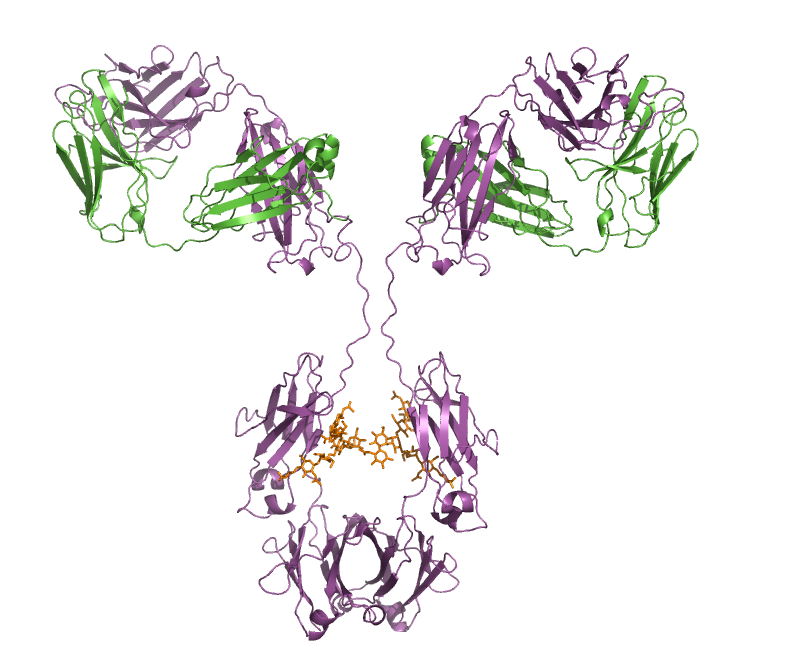The activities of the team "Immunoanalysis and Diagnostics" focus mainly on the production, characterization of polyclonal or monoclonal antibodies directed specifically against molecules or microorganisms of interest.
Team Leader
Stéphanie Simon
stephanie.simon@cea.fr
The antibody, from design to production...
After design, the antibodies are used to develop efficient immunoanalytical methods to detect and/or quantify. This phase often involves partnerships with both public research organizations and industrial clients. The obtained results lead to the writing of scientific publications but also to commercialization.

The antibody, a tool for Biosecurity
Following the terrorist attacks of 2001 and in view of our expertise, we initiated in 2001 a major program on Biosafety (CEA CBRN program). We have selected some molecules of interest (toxins) and some pathogens (agent of plague or anthrax) to develop appropriate immunological tools.
We have developed two parallel methodological strategies. The first approach is to develop "classic" immunoassays in 96-plate format, then using different revelation methods (enzymatic, fluorescent, electrochemiluminescent markers). The second approach is to develop a strip-kind immunochromatographic technique. This method retains the antibody specificity characteristics while allowing the getting of fast results from the field.
The LERI has a polyclonal and monoclonal antibodies (PRODIG) production platform and security levels 2 and 3 laboratories (L3 Laboratory) for manipulation and production of toxins and pathogens.

The antibody, a tool for the detection of early markers of autoimmune diseases
In the autoimmune process of type-1 diabetes, several auto-antibodies directed against antigens of the beta cells of the pancreas are produced. These auto-antibodies can be present years before the revelation of the disease, allowing early diagnosis before clinical manifestations.
We develop new assay formats for the simplex and mutiplex detection of auto-antibodies in the context of type-1 diabetes. This work could be extended to the detection of auto-antibodies involved in other autoimmune diseases.

The antibody, a tool for the development of new technologies
In collaboration with the Physics and Chemistry of Surfaces and Interfaces Unit (CEA Saclay DSM-IRAMIS-SPCSI), we use antibodies for the development of low-cost sensors for diagnosis or detection. These sensors are developed using different technologies (polymers, 3D paper fluidic, acoustic surface waves, and atomic force microscopy - AFM).

The antibody, a therapeutic and vaccination tool
If vaccination or antibiotics may represent means to fight against live pathogens, it is not the same for most toxins. Indeed, after contamination only palliative care is applied and one of the few fast and effective strategies is the mass administration of an antibody capable of neutralizing the target (by inhibiting binding to its receptor, for example) or premature destruction by other immune effectors. This passive immunotherapy is being used with some success in the cases of botulism by injecting an equine antiserum, but with important side effects (up to anaphylaxis).The production of chimeric recombinant antibodies (mouse/human) or humanized therapeutic against these toxins is therefore an important goal. Antibodies able to neutralize the botulinum toxins, A and E and ricin (for which there is no effective treatment) were produced and characterized.
From a more fundamental point of view, the laboratory is interested in understanding some of the molecular mechanisms that rule the immunogenicity of proteins to develop original approaches:
• to increase the immunogenic capacity of proteins with vaccine interest
• to produce "in vitro" human antibodies with therapeutic interest. This research has the primary objective of understanding what are the characteristics of a protein that make it capable of triggering a certain level or a certain type of immune response.
A second goal is to use this understanding to develop new approaches to increase the immunogenicity of protein antigens of vaccine interest or produce "in vitro" human antibodies of therapeutic interest. It was shown that the stability of the antigen controls the antibody response and the team has used this knowledge to define new highly immunogenic vaccine candidates derived from transcriptional transactivator (Tat) of the human immunodeficiency virus (HIV). We also study the self-adjuvant property of Tat because this characteristic, a rare one in proteins, could be used to create new highly immunogenic protein vaccines in the absence of adjuvant.
The team also studies the potential role of heparan sulfates in the immune response and we aim to assess whether the immunogenicity of vaccine proteins can be increased when they are targeted towards these sulfated sugars.
Finally, the laboratory studies the capacity of Tat-containing fusion proteins to induce "in vitro" immune responses because this special feature, rare in proteins, could allow the development of a new strategy to produce "in vitro" human antibodies with therapeutic interest.